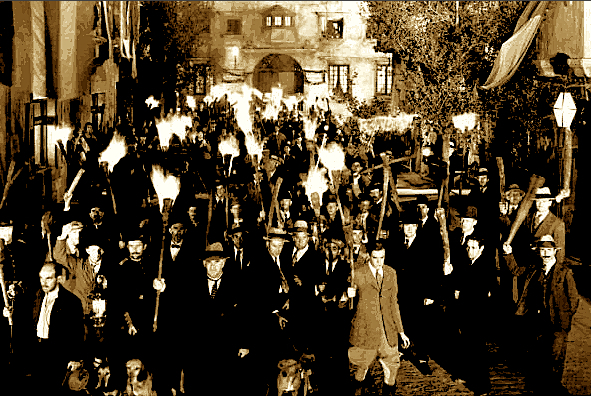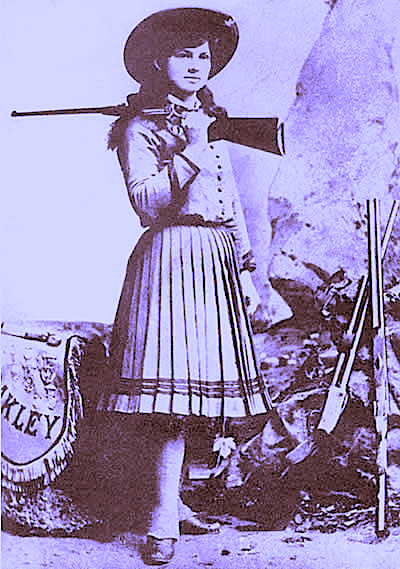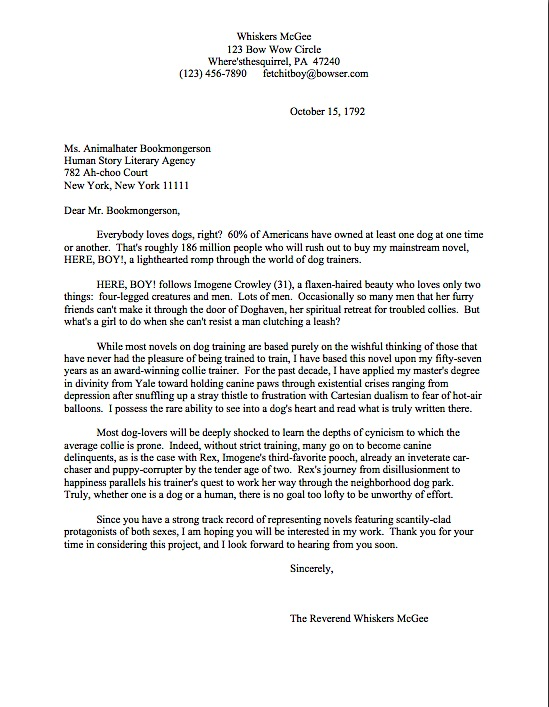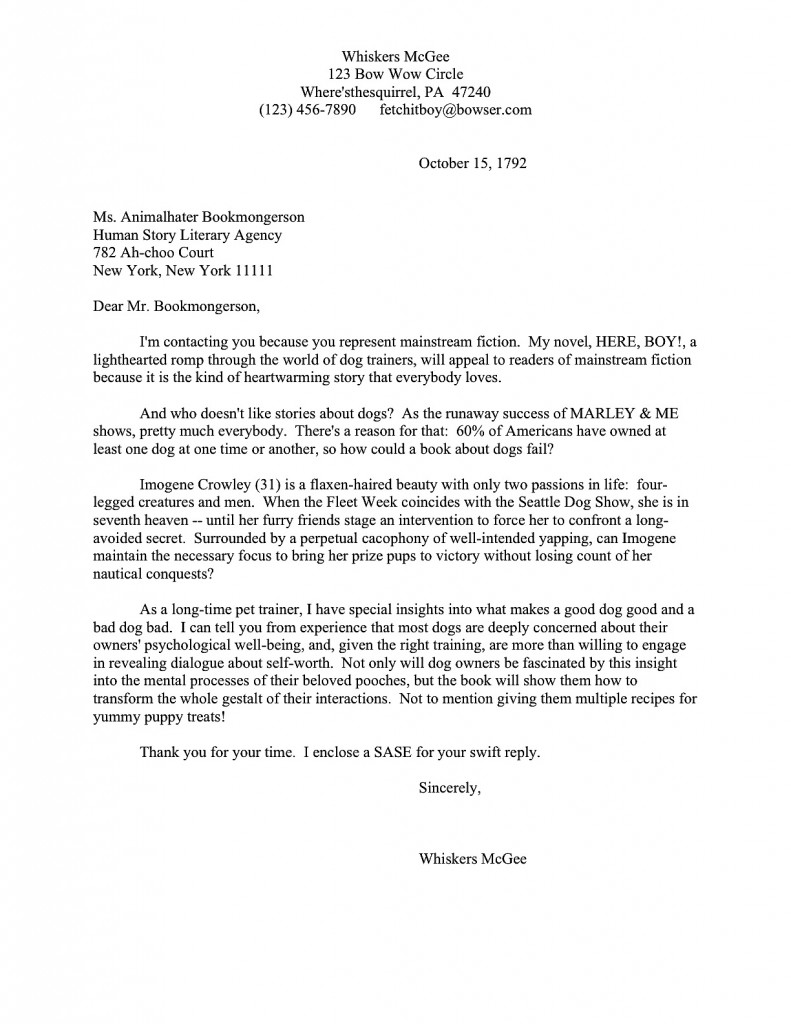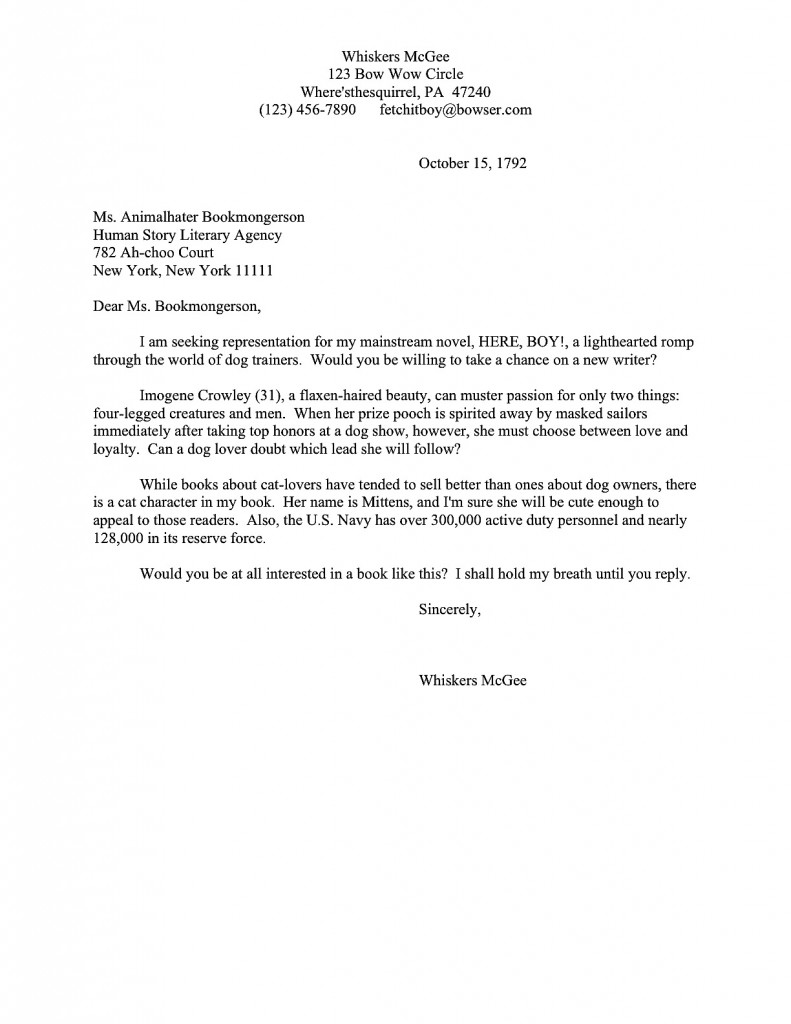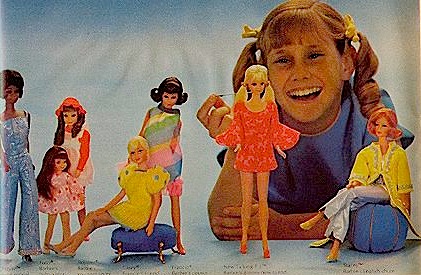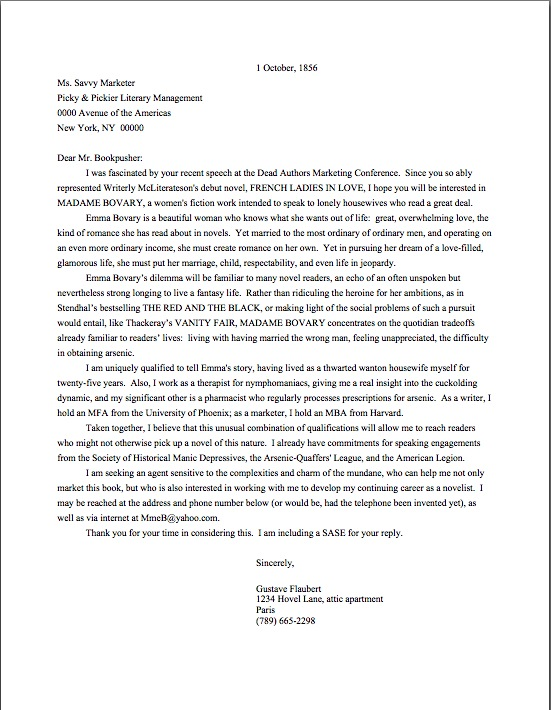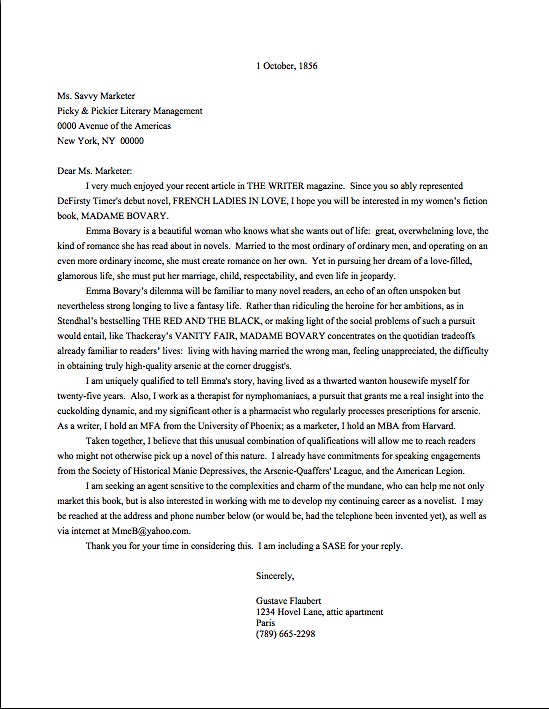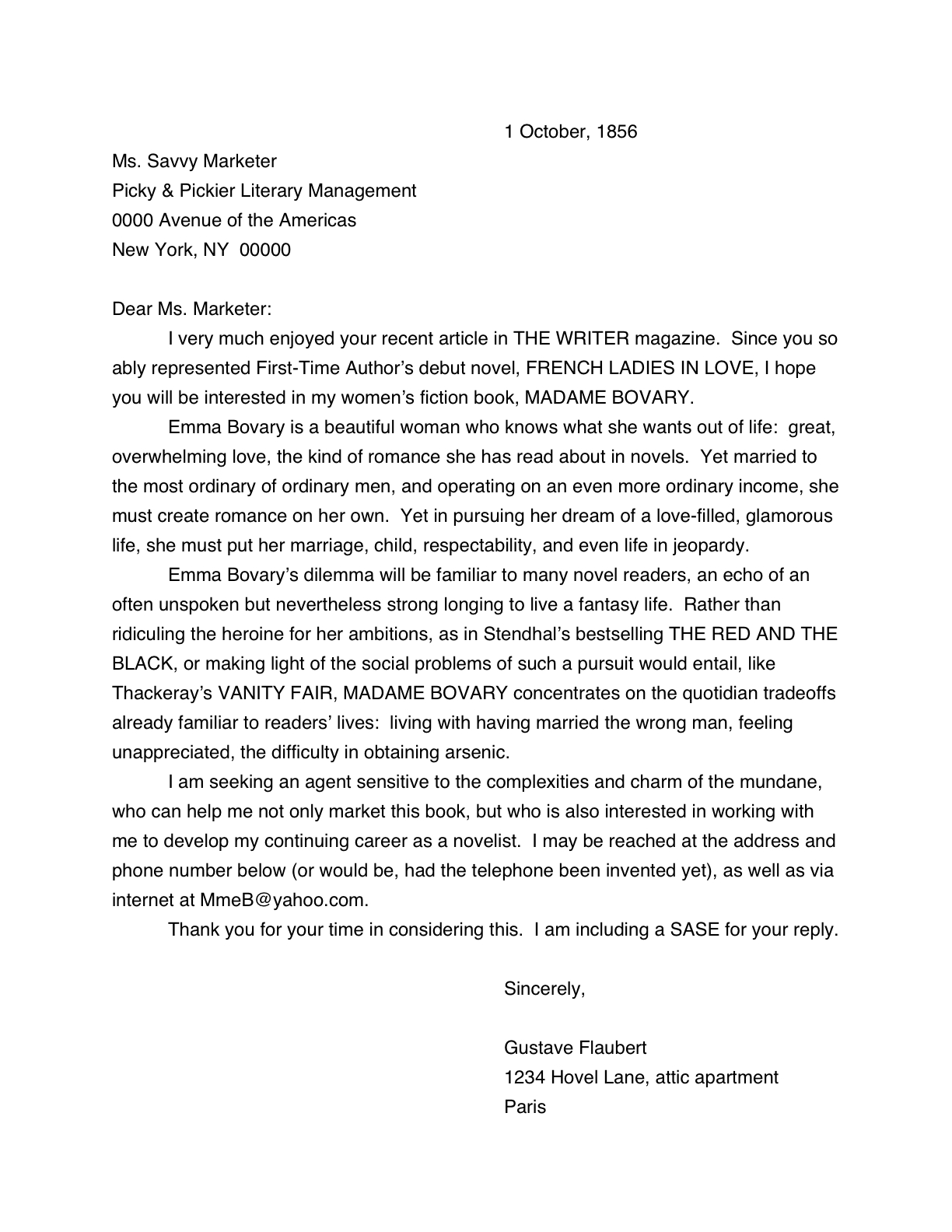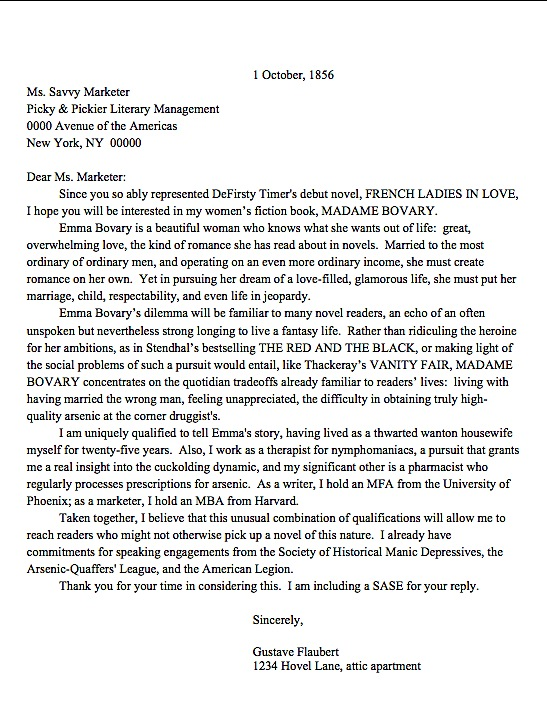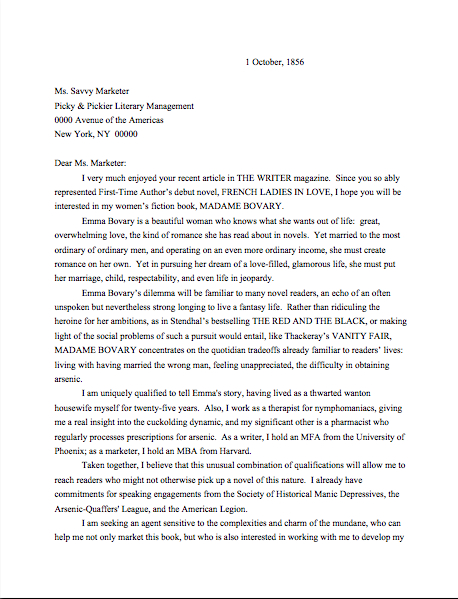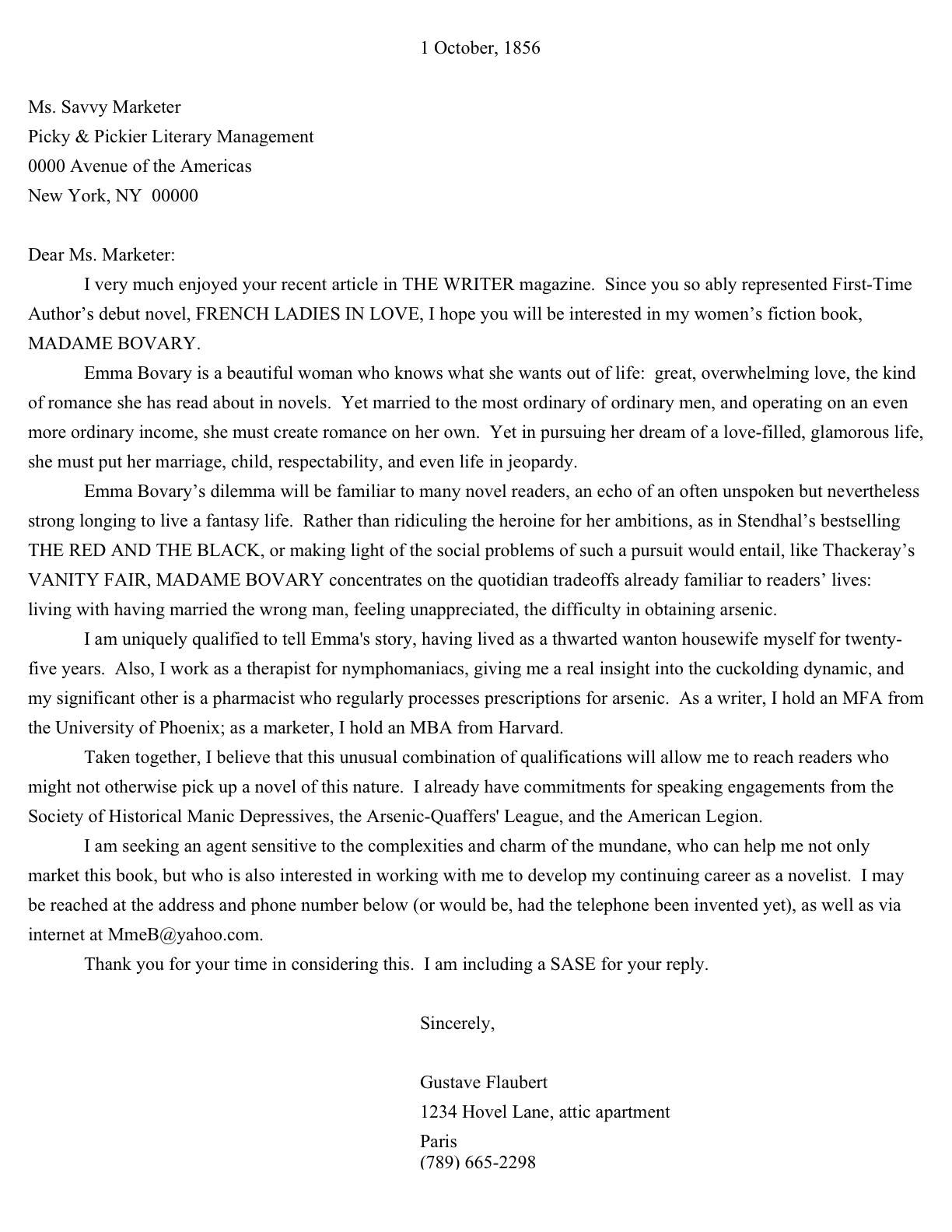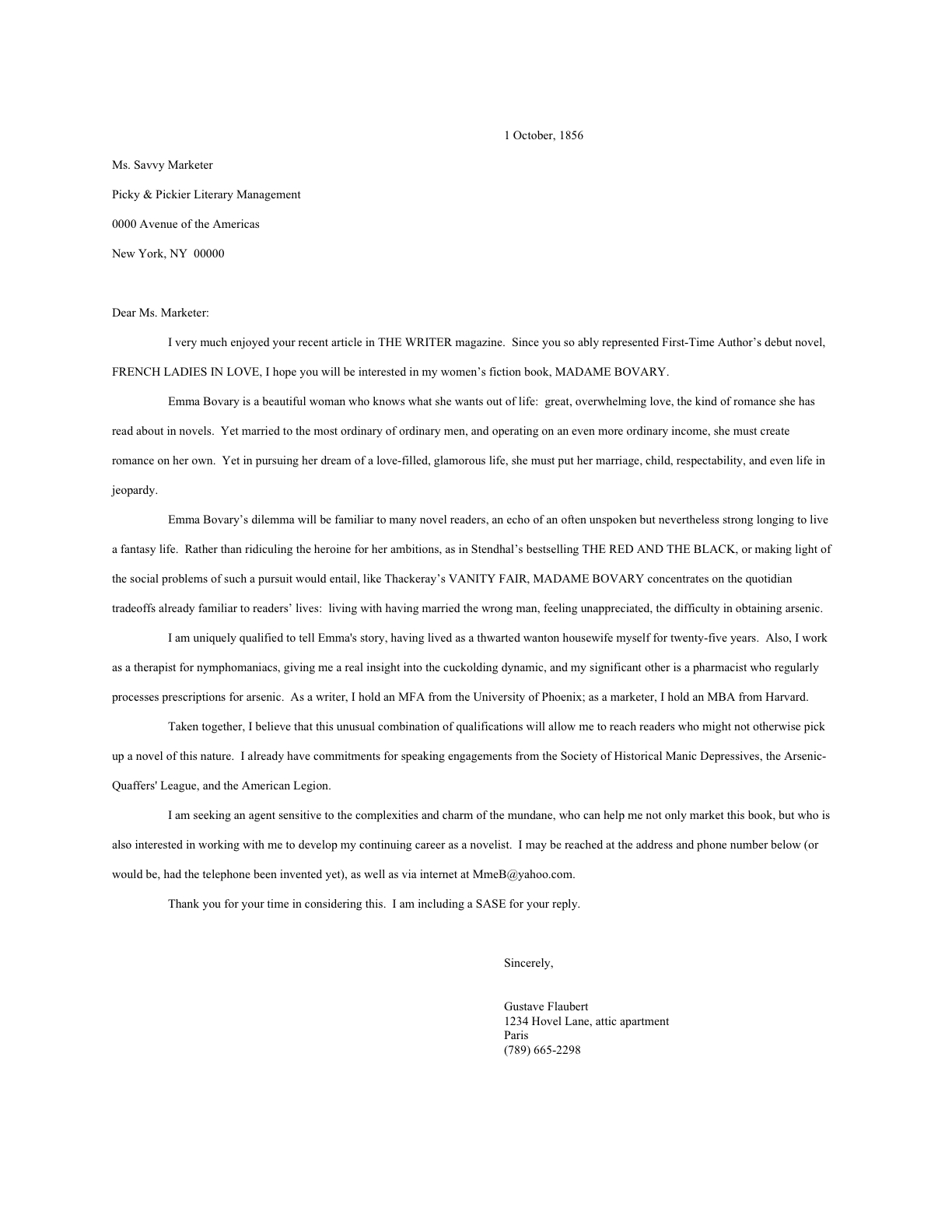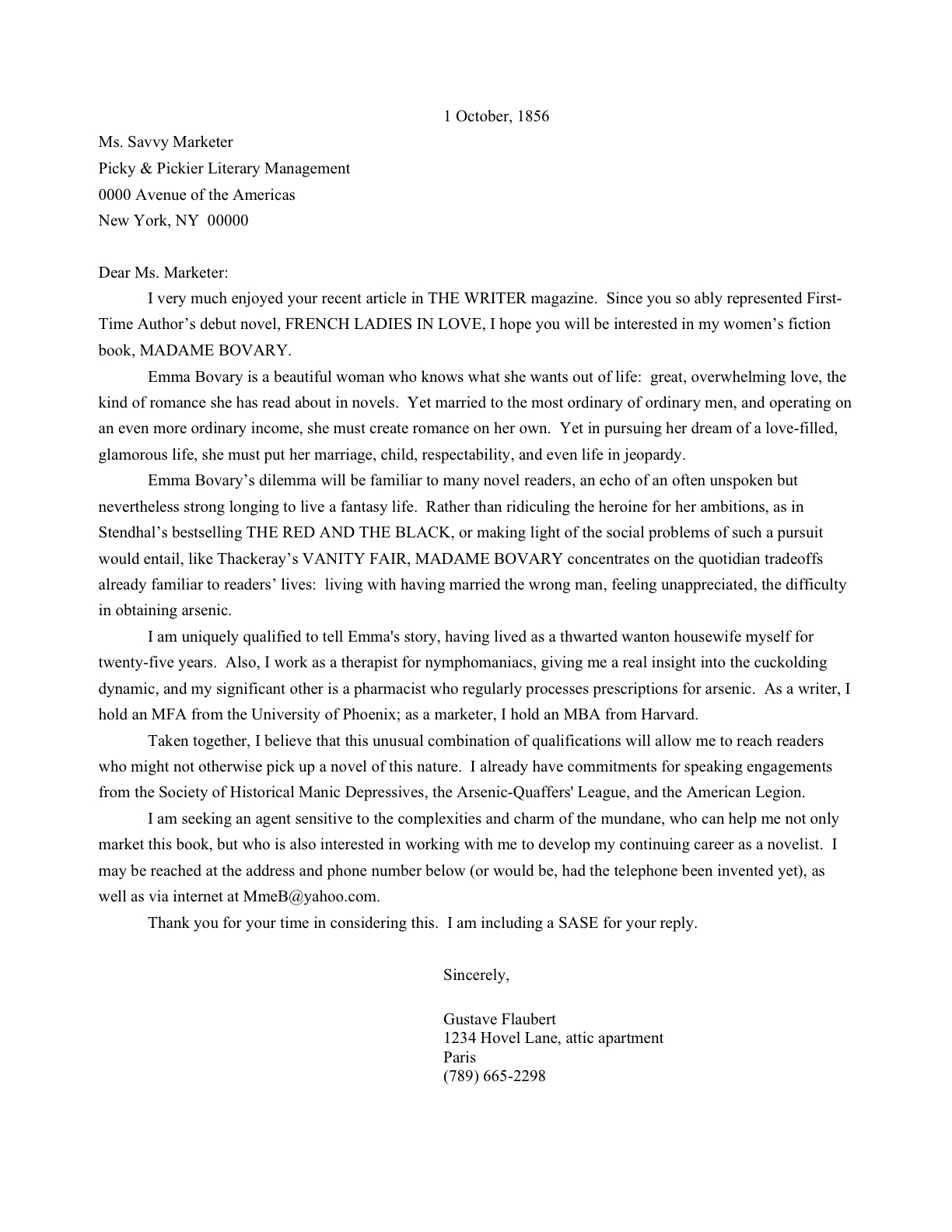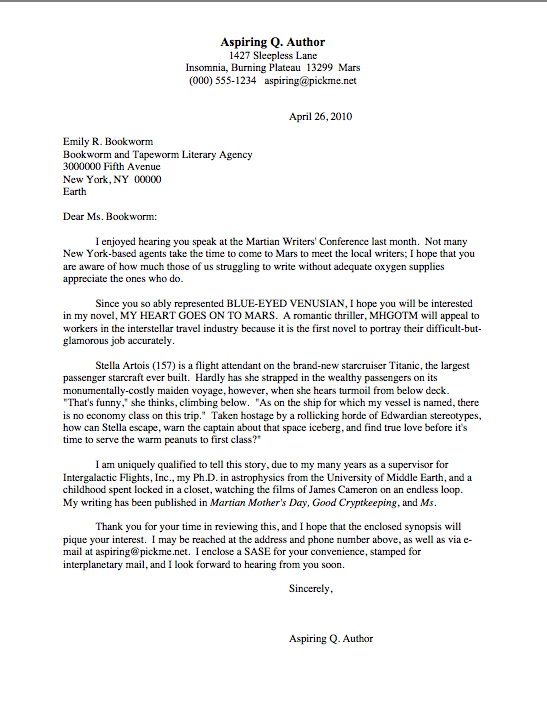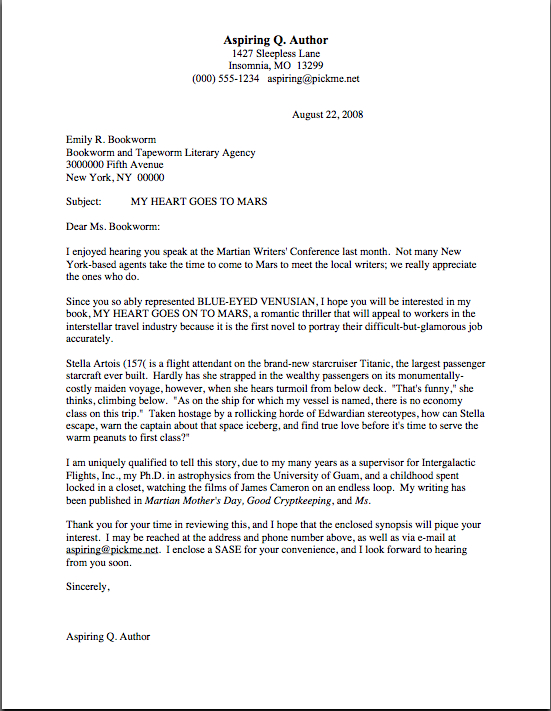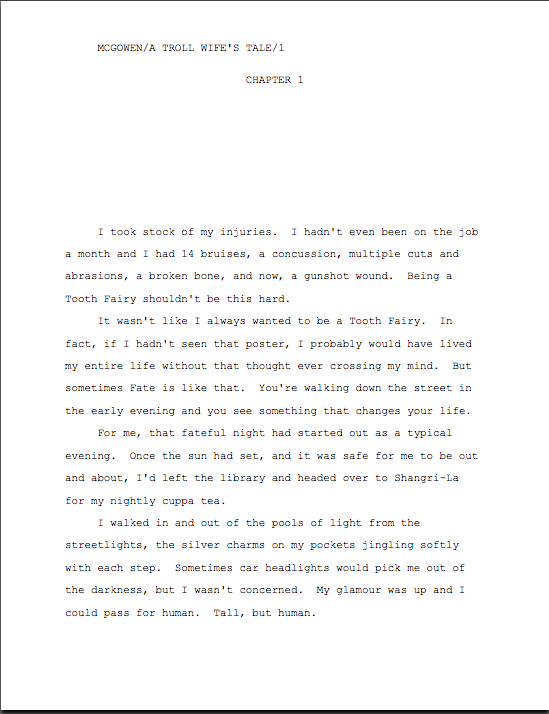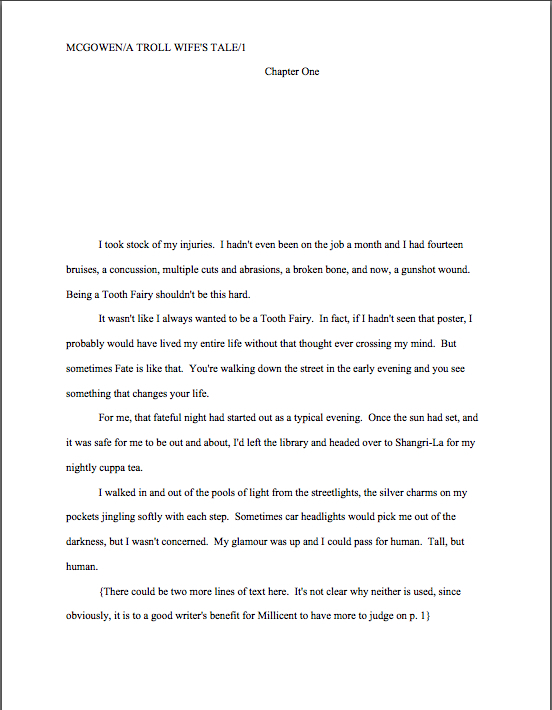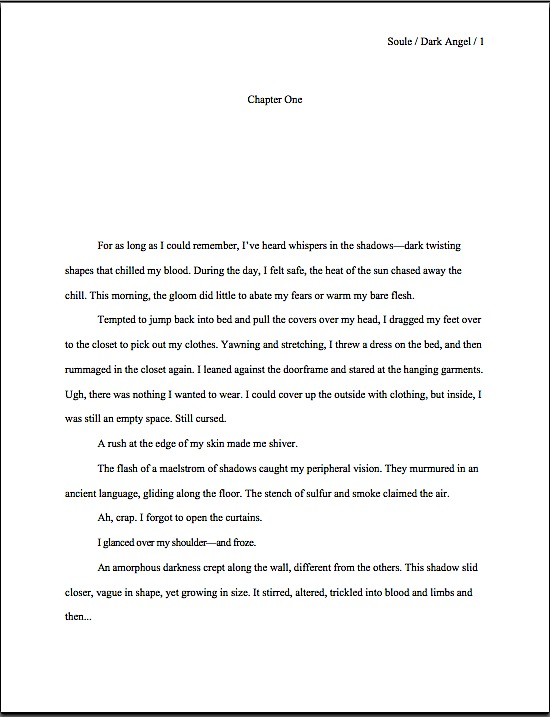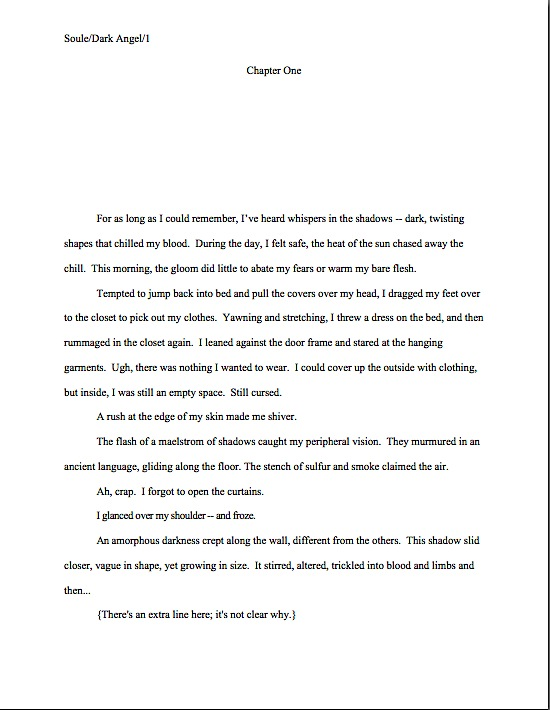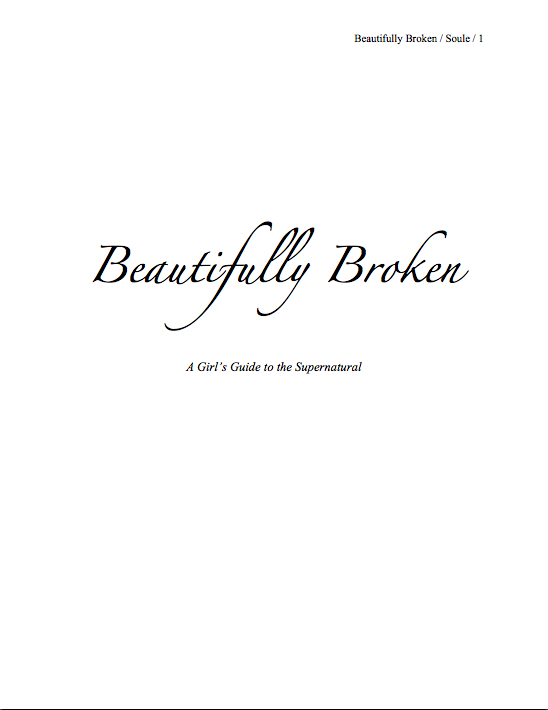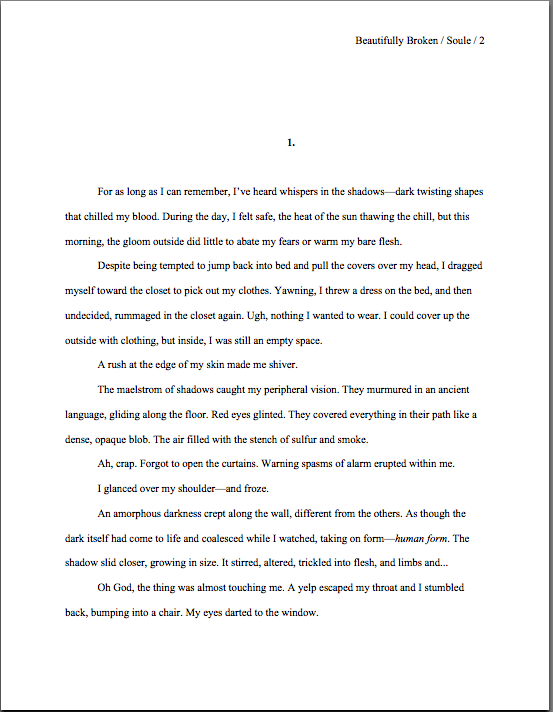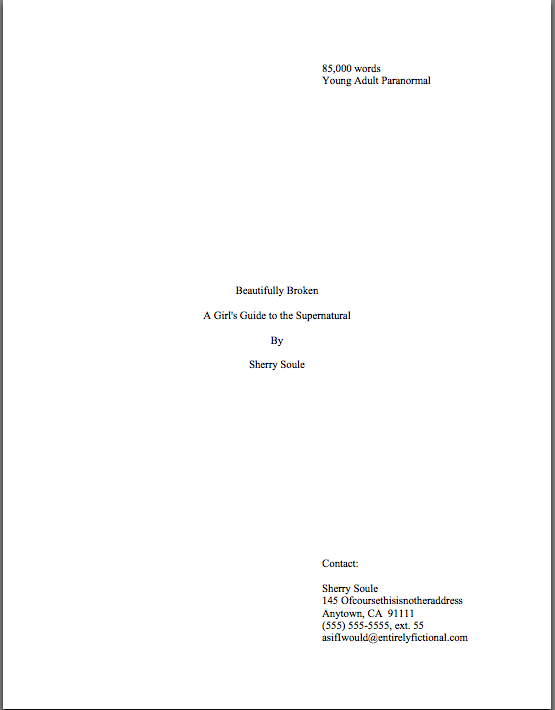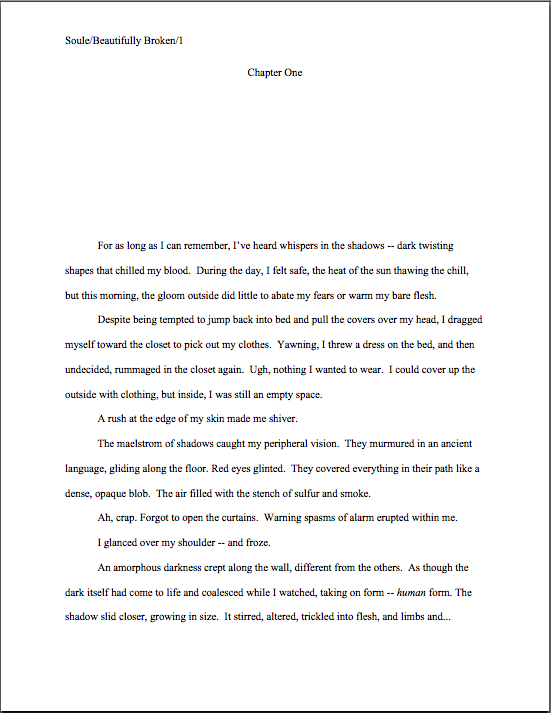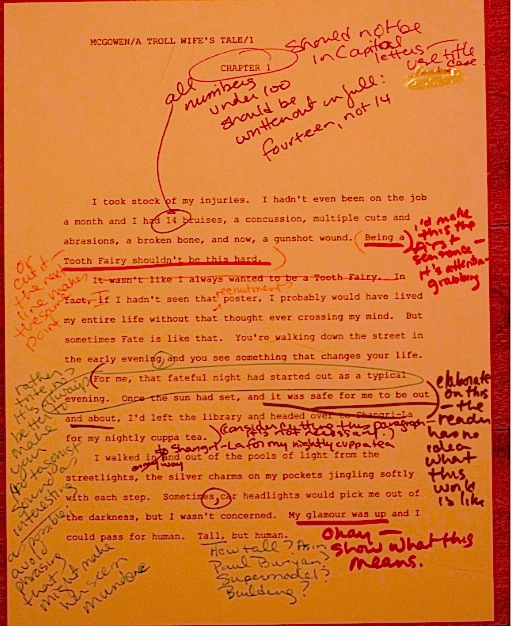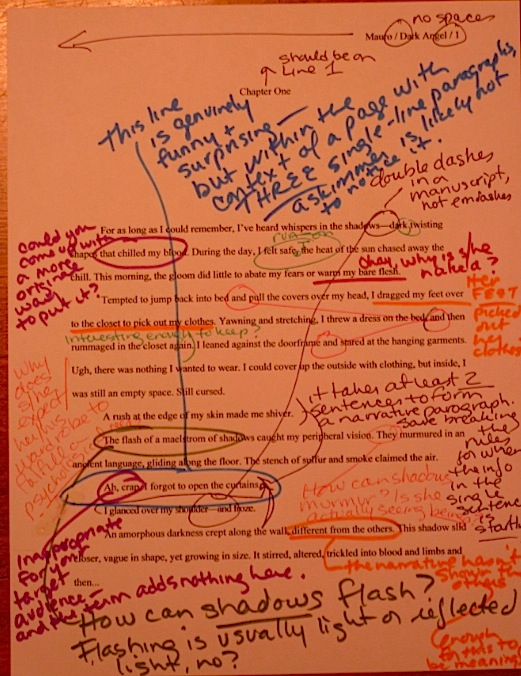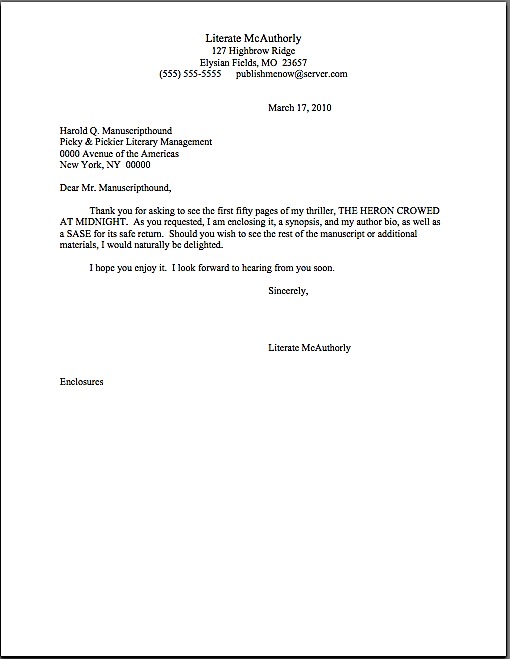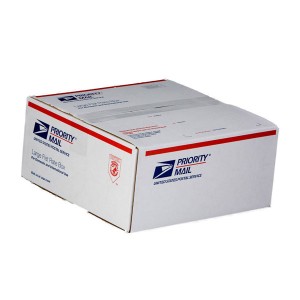How are you faring, Queryfest participants? (I was on the cusp of dubbing you Queryfesters, but the image the word evoked was a trifle distasteful. An editor never stops thinking about how words will scan on a page, as well as what they mean and how they might sound spoken aloud.) Are your queries looking bright, shiny, and relatively free of the straightforward errors and omissions that dog the garden-variety letter to agents?
Or — and please be honest with me; I can take it — is your original query concept now hanging in tatters, wafting in the wind, mournfully longing for the day when it felt ready to stride out the door and into Millicent the agency’s screener’s overflowing inbox, blithely unaware of just how stiff the competition is there?
Oh, those of you who felt this way thought you were alone? Actually, it’s a pretty common response to realizing for the first time that in the publishing world, every syllable of everything a writer submits is a writing sample. There’s no such thing, then, as a successful query that’s just kinda close to what Millicent has been trained to seek, nor is just hitting every point on an agency’s posted querying guidelines generally sufficient.
I feel an aphorism coming on: while those new to querying often presume that the query is just a formality, composed of a series of hoops through which an aspiring writer must jump, and that their writing will not be judged until an agent requests and receives manuscript pages, that is simply not how the system works. For the overwhelming majority of aspiring writers out there, the query letter is literally the only sample of their writing anyone at the agency will read.
To put it another way, in order to get an agent (or editor, at a small publisher) to read any of your manuscript at all, you will first have to convince her to do so. Querying and pitching are your only options to do that politely — and frankly, most writers’ conferences that allow pitching are quite expensive. As querying is the lower-cost option, a good agent’s inbox, either tangible or virtual, constantly overflows with missives from aspiring writers.
A good half of those communications will be so unprofessionally put together, poorly written, and/or missing crucial pieces of information — the type of book it is, for instance — that Millicent the agency screener will be able to tell at a glance that her boss, the agent, will not be interested. Another third will be better written and contain most or all of the necessary elements, but will arrive at agencies that just don’t represent that kind of book. (Yes, really — you’d be astonished at how few queriers seem to research agents before hitting SEND.)
Then there’s that top 17% or so, the conscientious writers that have taken the time to learn something about how agencies actually work. Their queries tend to be aimed at agents who represent books like theirs, at least, but they often undersell their own stories by trying to make them sound too much like a recent bestseller. Or mystify Millicent by not indicating a book category at all. Or even — sacre bleu! — inadvertently make themselves look unprofessional by adopting an inappropriately informal tone (Hi, George. Looking for solid memoirs by self-made businesspeople — well, have I got a book for you!), engaging in a generic hard sell instead of demonstrating the book’s market appeal (This is the next Great American novel, and you’d be a fool to pass up your chance to get in on the ground floor of what’s sure to be a blockbuster series!, or making claims that reveal they’ve just not bothered to do very much research about what books like theirs are gracing bookstore shelves these days (This is the only novel ever written about a woodcarver’s deep love of his craft, a devotion so profound that his pieces seem alive to him.)
“Yeah, right!” Millicent chortles, reaching for the omnipresent stack of form-letter rejections. “Hey, Geppetto, ever heard of an obscure book called PINOCCHIO?”
I sensed at least 5% of you shifting in your seats. “Gracious, Anne,” the time-strapped cry, clutching their suddenly pale cheeks. “I get that it’s in my best interest to pick a book category and target only agents who represent it, but what makes you think I have TIME to keep up with all of the latest publications in my chosen genre? It took me years to carve out the requisite hours to write my manuscript/draft my book proposal, and having to query at all, much less construct a synopsis, is eating great big holes into my revision time. Isn’t it more important to write a good book than to figure out how to sell it to an agent?”
Well, yes and no, pale clock-watchers. Yes, your chances of getting published are substantially higher if you have written a good book, but that alone is not sufficient endeavor to land an equally good agent for it — a fact which, unfortunately, most first-time writers of good books don’t figure out until they have been querying for a while.
Often not even then. Hands up, everyone who has heard a rejected fellow writer complain that the publishing world just isn’t ready for his book — that it’s too revolutionary, uses language too well, presents an entirely new spin on human relationships, exposes a secret unlike any that has been seen on the printed page before, etc. Keep those hands in the air if, upon subsequent questioning, you discovered that this paragon of literature got rejected at the query stage, rather than as a submission. And wave those hands mightily if you said, either to yourself or to the huffy writer, “Excuse me, Ambrose, but if all the agent saw was your query, how could your startling insights, blistering prose, and/or trenchant analysis of the human condition have been the reason she rejected it? Mightn’t the problem have been, you know, the query?”
Because I love you people, I’m not going to ask those of you who have been the Ambrose in this situation to raise your hands. You know who you are.
I am, however, going to ask Ambrose and those who happen to be personally fond of him to take a moment to ponder the possibilities here. Far too many talented aspiring writers assume that the only reasons their queries could have been rejected is some problem with the book: the story’s not marketable enough, publishers stopped buying chick lit two years ago, the protagonist sounds like a downer, etc. Accordingly, they become discouraged — what would be the point of continuing to query a rejected book? — and just give up.
I get why giving up on querying might be tempting — honestly, I do. However, there’s no denying that the book that isn’t particularly marketable today may well be next year, or even next month; keeping a weather eye on recent releases could help you there. It’s also undoubtedly true that agents’ tastes often change over time, as do agencies’ plans for where they want to place their focus, so the agency that rejected your last book flat might well be interested in your next. And let’s face it, where one agent (or, more likely, his Millicent) does not see market potential, another will, but you’re not going to find that out unless you persevere.
Then, too, if your query lands on the wrong desk, no matter how great the book in question is, or even how beautifully the query is written, it doesn’t stand a chance, right? The same principle applies if you approach the wrong agent within an agency; since the standard etiquette dictates that a writer may query only one, it honestly is worth doing your homework first. You can also kiss that agent goodbye– and you wouldn’t believe how common this is — if you queried the perfect agent too soon after you finished writing the book, before you’ve had an opportunity to go back over it with the proverbial fine-toothed revision comb.
You were aware, right, that you’re only supposed to query any given agent once with any given writing project? Oh, Millicent turnover is so rapid these days that it’s unlikely that the same human being will screen your query two years apart, but if you realize three months hence that Chapter 2 contains a huge continuity problem, sending a repeat query isn’t likely to revivify your prospects at that agency.
As frequently as Millicent sees all of these faux pas — especially the one about beginning to query too soon: now that many agencies allow queriers to include the first few pages in their query packets, it’s apparent far earlier in the process who has and has not taken the time to re-read or even proofread her work — there’s one that crosses her desk even more. I am referring, of course. to the query that reads exactly like 30 others she has read that day, for the exceedingly simple reason that there’s a template out there that 31 of the day’s queriers heard somewhere was sure-fire.
Trust me on this one: a personalized query will stand out in that crowd — and one that sounds remotely like you’ve done some reading of recent releases in your chosen book category will practically bring tears of relief to Millicent’s weary eyes. Returning to our query troubleshooting list…
(25) Is it clear from my query that I’m familiar with recent releases like mine? Even better, do I sound as though I have picked this agent based upon that familiarity?
This may seem like a subtle one from the writer’s side of the querying relationship, but on the query page, it’s often painfully obvious if the querier is thinking of both his book and his query list in generic terms: he has a book to sell, and agents sell books for writers, so any agent who sells remotely similar books will do, right?
Wrong. No agent represents every kind of fiction — and certainly not every conceivable kind of memoir. Actually, although it may be hard to tell this from a brief blurb in an agency guide, it’s relatively rare for agents not to specialize within a particular book category. And I’m not just talking about an agent’s preference for Highland romance over romances set in Ancient Rome, either: these people often like to see particular types of sentence describing those lads and lassies. As will soon be apparent if you take the time to go to a bookstore, pull recent books by three or four of the agent’s clients of the shelves, and read a few opening pages.
Research, my dears, research; there’s just no substitute for it — and the more specifically you can show the fruits of that research, the better. Why, you ask? In the interest of inculcating good writing habits, instead of telling you, I shall show you.
Let’s say, for the sake of example, that Desperate Togetpublishedson has written a YA novel set against the backdrop of the highly competitive junior show jumping circuit, a sterling piece of literature entitled NEVER SAY NEIGH. Let’s further assume that Desperate wants to query Literate McSalesperson, an agent with a long-established track record of selling books about horses and the preteens who love them.
That’s a great choice, probably based upon some solid research on who’s selling books like Desperate’s these days. But Literate’s Millicent would never know it from a query that opened like this:
Because you represent YA aimed at young girls, I hope you will be interested in my novel, NEVER SAY NEIGH. Fifteen-year-old Fifi never dreamed she would be faced with a wall that high…
That’s not bad, but Desperate’s honest-to-goodness market research doesn’t really shine here, does it? The bit about Literate’s representing YA for young girls could have been gleaned by the most cursory glance at one of the standard agency guides — or even a simple web search. (And news flash: most YA is aimed at young girls; they tend to read more than young boys.)
Let’s take a peek at what happens if our Desperate decides to be a trifle more specific.
I read in Jeff Herman’s Guide to Literary Agents that you were “looking for YA with strong female protagonists.” My novel, NEVER SAY NEIGH, definitely fits the bill: it’s about a young girl overcoming obstacles ranging from low tree branches to high walls to uncaring adults in her pursuit of becoming a champion show jumper.
Fifteen-year-old Fifi never dreamed she would be faced with a wall that high…
Better, isn’t it? If a trifle literal-minded: does the direct quote of what anyone in the industry would consider a fairly generic preference honestly help the case here? And does it really matter where Desperate picked up this information? A less pedantic presentation of the same information would make the same point without — please forgive my putting it this way, but it is how Millicent would think of it — sounding as though Desperate had read somewhere that he should include a reason for approaching Literate, but couldn’t come up with anything specific?
Calm down, Desperate, and try it again. Literate isn’t really looking for citations here.
Since you represent YA with strong female protagonists, you may be interested in my novel, NEVER SAY NEIGH. It’s the story of a young girl overcoming obstacles ranging from low tree branches to high walls to uncaring adults in her pursuit of becoming a champion show jumper.
Fifteen-year-old Fifi never dreamed she would be faced with a wall that high…
Ah, that’s nice — but if Desperate actually did go to the trouble of tracking down some other books Literate represented, that professional-level effort is not apparent here. Citing a specific book would leave no doubt on the matter. It’s an especially nice touch to bring up a first-time author’s title, underscoring that Desperate has done the requisite research to realize that Literate does take a chance on a new voice from time to time. (Not a foregone conclusion in the agenting world, by the way; it’s worth your while to check.)
Since you so ably represented Debuty de Firsttimer’s HOW AM I EVER GOING TO CLIMB INTO THAT SADDLE? I hope you will be interested in my YA novel, NEVER SAY NEIGH. It’s the story of a strong, determined young girl overcoming obstacles ranging from low tree branches to high walls to uncaring adults in her pursuit of becoming a champion show jumper.
Fifteen-year-old Fifi never dreamed she would be faced with a wall that high…
“But Anne!” the literal-minded cry, and who can blame you? “That nifty bit about the strong protagonists fell out of this version! Since Literate feels strongly enough about that preference to have mentioned it in her guide listing, shouldn’t Desperate bring it up?”
Ah, but Desperate did bring it up — by depicting his protagonist as strong, rather than just saying she was. Nifty trick, eh?
Do be certain, though, that any book you cite actually is comparable to yours. Don’t stray outside your book’s category, or you’ll defeat the purpose here. I hate to show a bad example, just in case blog-skimmer out there decides to copy it under the assumption that I meant it as a guide (oh, you’d be astonished at some of the comments I get from people who don’t read carefully), but as Desperate has been generous to make this mistake first, I’d like you to benefit from his sad experience.
Since you handled science fiction writer Outta Myleague’s extraordinary debut, THIS STORY HAS ABSOLUTELY NOTHING TO DO WITH YOUNG GIRLS OR HORSES, I am writing you in the hope that you will be willing to represent my YA novel, NEVER SAY NEIGH, the story of a strong, determined young girl overcoming obstacles ranging from low tree branches to high walls to uncaring adults in her pursuit of becoming a champion show jumper.
“Excuse me?” Millicent cries. “Do you not understand the term science fiction? Why on earth would an agent interested in one book want to read the other?”
Good question, Millie. Unfortunately, you’ve already rejected Desperate’s query, so I doubt you’re going to have the opportunity to discuss the matter with him anytime soon.
Do all of those glazed eyes out there indicate that some of you are frantically searching through your memories, trying to recall tidbits you have read about various agents and the books they have represented? Excellent. I have a bit more to say about how you might turn that information to your advantage, but in order to give you all some processing time, I’m going to veer our discussion back toward matters more technical.
(26) If I intend to submit this query to agents based in the United States, have I used ONLY US-spellings throughout my query packet? Or U.K. spellings, if I am sending it there or to Canada?
Hey, I told you the next one was going to be technical. While honour, judgement, and centre are perfectly correct in some places in the English-speaking world, they are incorrect in the US, just as honor, judgment, and center are on the other side of the pond, or even north of the border. And while your spell-checker may not find fault with either version, a New York-based Millicent is going to take one look at the former and say, “Great. Now some poor soul is going to have to comb through this manuscript, changing everything to U.S. spellings.”
I hate to burst any bubbles currently floating outside U.S. borders, but the publishing world’s opinion is united about who that poor soul should be: the writer. Who, let’s face it, might not be all that happy about the prospect. So in practice, when a query turns up here with U.K. or Canadian spellings, it says to Millicent, “Hi! If you ask to see this manuscript, not only will your finely-tuned editorial sense have you longing to correct the spelling every other page, but if your boss falls in love with the writing, she will have to have a rather unpleasant conversation with the writer.”
Yes, I am saying what you think I am, far-flung writers: if you’re planning to write for the American market, Millicent will expect you to use U.S. spellings in your query. Her boss is going to insist that you alter every single instance in your manuscript, anyway, so why not beat the Christmas rush and do it now?
You’re quite right — it’s annoying, but honestly, Millicent and her ilk have a point here. While books that have already hit the big time in the U.K. or Canada are routinely available in their original forms here, the original publication site dictates what is considered proper. Since a previously-unpublished manuscript with U.K. spellings would have to be altered before it could be released in the U.S. market, can you blame an agent for considering such a manuscript not ready for circulation to domestic agents?
At the query stage, though, the presumption of further revision’s being needed is not the only danger. You don’t want Millicent to think that you just don’t know how to spell, do you, oh centred, honourable person of sound judgement?
The same principle applies in reverse, of course: tailor your query and submission to what will look right to your intended audience, the agent, based upon where he resides. If you’re a Yank approaching a U.K.-based agent, you’ll be better off conforming to his view of the English language. (Unless, of course, you happen to be an American celebrity — then, your oddball spellings will be part of your complicated charm.)
Ready to start talking about books like yours again? Dandy.
(27) When I mentioned the book category in the first paragraph of my query, did I use one of the established categories already in use by the publishing industry, or did I make up one of my own?
Queriers new to the game often believe, mistakenly, that claiming that their books are so completely original, so unlike anything else currently for sale to the English-reading public, that even trying to squeeze them into one of the conceptual boxes provided by the industry would undersell their originality. Instead, these well-meaning souls just make up their own categories with names like Hilarious Western Romance with a Futuristic Feel to It or Time-Travel Thriller with Magical Realist Elements.
They think — again, mistakenly — that such descriptors are helpful to agents. How could being more specific than the average bookseller’s shelving system be bad?
In quite a number of ways, actually. To name but two, mythical book categories are unprofessional, and using them betrays a misunderstanding of why agents want to see them in query letters: to figure out whether the book presented is the kind that they currently want to sell. Also, an aspiring writer who clearly knows that she’s supposed to name a book category but tries to wiggle around it is playing rules lawyer, not a strategy likely to convince Millicent and her boss that she’s the type who just loves following directions without a fight.
Do it because they say so. If you’re at a loss about how to go about narrowing down the choices, please see the HOW TO FIGURE OUT YOUR BOOK’S CATEGORY section on the archive list at right.
“Can’t make me!” some rebels shout. “No one’s going to put my book in a conceptual box.”
That’s quite true: no one can force an aspiring writer to commit to a book category — at least before she’s signed with an agent, of course. Agents make their clients commit all the time. In fact, it’s not all that unusual for an agent to accept a new project as one category, ask for targeted revisions, then pitch it to editors as a different category.
A book category is nothing but a — wait for it — conceptual box, after all, a marketing label used to get a manuscript to the people who represent and sell similar books. So a categorical (so to speak) refusal to allow your work to be labeled at the query stage isn’t going to impress anybody familiar with how books are sold in this country.
Especially not Millicent — and especially if she happens to open your query at an inopportune moment.
Don’t believe me? Okay, picture this: Millicent’s subway train from her tiny apartment in Brooklyn that she shares with four other underpaid office workers has broken down, so she has arrived at work half an hour late. There’s an agency-wide meeting in an hour, and she needs to clear her desk of the 200 query letters that came yesterday, in order to be ready for the 14 manuscripts her boss is likely to hand her at the meeting. (Starting to read like a word problem in a math class, isn’t it?) After she has speed-read her way through 65 of the queries, a kind co-worker makes a Starbucks run. Just before Millicent slits open your query (#126), she takes a big gulp of much-needed caffeine — and scalds her tongue badly.
Oh, as though long-time readers of this blog didn’t see that coming.
Your query with its fanciful pseudo book category is now in her hand. What is she more likely to do, to humor your reluctance to place your book in the traditional conceptual box, as her boss will require her to do if she recommends picking you up as a client, or to shrug, say, “Here’s another one who doesn’t understand how the business works,” and move on to the next envelope?
Blistered tongue or not, do you really want to bait her? More to the point, is it really in your best interest to bait her?
If you’re absolutely, positively convinced that it would be an outrage upon the very name of truth to commit your novel to any one category, PLEASE don’t make up a hyphenate like Western-Vampire Romance-How-to, in order to try to nail it with scientific precision. In a pinch, if your novel doesn’t fall clearly into at least a general category, just label it FICTION and let the agent decide.
Provided, of course, that you are querying an agent who routinely represents fiction that does not fit neatly into any of the major established categories. I definitely wouldn’t advise this with, say, an agent who represents only romantica or hard-boiled mysteries.
But whatever you do, avoid cluttering up your query letter, synopsis — or indeed, any communication you may have with an agent or editor prior to clutching a signed contract with them in your hot little hand — with explanations about how your book transcends genre, shatters boundaries, or boldly goes where no novel has gone before.
Even if it’s true. Perhaps especially if it’s true.
Yes, such a speech makes a statement, but probably not the one the writer intends. Here’s how it translates into agent-speak: “This writer doesn’t know how books are sold.”
(28) Have I listed my credentials well in my platform paragraph? Do I come across as a competent, professional writer, regardless of my educational level or awards won?
I’m going to be revisiting the platform paragraph in more detail in a future post, but here’s the short version: if you have any background that substantially aided you in writing this book, you need to make sure you mention it in your query.
Period. Even your camp trophy for woodworking can be a selling point, in the proper context. Ditto with any publication, anytime, anywhere, regardless of whether you were paid for writing it. A publication is a publication is a publication.
But truthfully, unless you are writing a book that requires very specific expertise, most of your credentials will not actually be relevant to your book. But do say where you went to school, if you did, and any awards you have won, if you have. To professional eyes, these too are what I like to call ECQLC (Eye-Catching Query Letter Candy).
If you are a member of a regularly-meeting critique group, feel free to mention that as well, although this one is less effective than it used to be 10 or 20 years ago. (The Internet has spawned some pretty wacky writers’ groups, and Millicent knows it.) Anything that makes you sound like a serious professional is appropriate to include, though.
If you don’t have anything you feel you can legitimately report here, don’t stretch the truth; writers who do this almost invariably get caught in the long run. (The same holds true for queriers who include recommendations from people who didn’t actually recommend them, by the way.) Just leave out this paragraph. Unless, of course, you happen to be trying to find an agent or editor for a nonfiction work. Which brings me to…
(29) If I am querying nonfiction, have I made my platform absolutely plain? Would even a Millicent in a hurry understand why I am uniquely qualified to write this book, if not actually the best-qualified person in the known universe to do it?
A platform, for those of you unfamiliar with the term, is the background that renders a nonfiction author qualified to write a particular book. Consequently, “What’s the author’s platform?” is pretty much always the first question either an agent or an editor will ask about any nonfiction book.
Which means, in practice, that a nonfiction query that does not make its writer’s platform absolutely clear and appealing will practically always be rejected. And yes, you do need to satisfy this criterion if your nonfiction field happens to be memoir.
I know, I know: it’s self-evident that a memoirist is the world’s leading authority on his own life, but as I’ve mentioned before, a memoir is almost invariably about something other than the author’s sitting in a room alone. If your memoir deals with other subject matter, the platform paragraph of your query letter is the ideal place to make the case that you are an expert on that.
(30) Have I made any of the standard faux pas, the ones about which agents complain early and often?
I like to think of this as a primary reason to attend writers’ conferences regularly: they are some of the best places on earth to collect massive lists of the most recent additions to agents and editors’ pet peeves. I’ve been going through most of the major ones throughout this series, but some of them can be quite itty-bitty.
Referring to your book as a fiction novel, for instance, is invariably on the top of every agent’s list; in point of fact, all novels are fiction, by definition. A nonfiction memoir, a real-life memoir, a true memoirand nonfiction based on a true story, as well as permutations on these themes, are all similarly redundant.
Just don’t do it. If you thought Millicent was in a bad mood after she burned her tongue, trust me, you don’t want to see how she reacts to that memoir based on something that really happened to me.
Waffling about the book category is also a popular Millicent-irritant, as are queries longer than a single page, including promotional blurbs from people of whom the agent has never heard (Delphine Margason says this is the most moving book about figure skating she’s ever read!), or — chant it with me now, folks — ANY mention of the book’s potential for landing the author on a show hosted by someone like Oprah. Or Jon Stewart. Or Stephen Colbert. Or Charlie Rose.
Or…well, you get the picture.
Violating any or all of these will generally result in the query being tossed aside, unread. Especially the last; the average screener at a major NYC agency could easily wallpaper her third-floor walk-up in Brooklyn seven times over with query letters that make this claim — and I’m talking about ones that fell onto her desk within the last month.
Believe it or not, we still haven’t run through all of the common Millicent-irritants out there — and we have barely begun taking a serious gander at examples of what does and doesn’t work on the query page. Join me next time for more on these exciting topics, and, of course, to keep up the good work!


 If there is a single rule of thumb that may be applied at every stage of any successful author’s career, it’s that it ALWAYS behooves us to look critically at our own writing, rather than assuming that the only possible explanation for frowned-upon writing lies in the eye of the predisposition of the reader to frown.
If there is a single rule of thumb that may be applied at every stage of any successful author’s career, it’s that it ALWAYS behooves us to look critically at our own writing, rather than assuming that the only possible explanation for frowned-upon writing lies in the eye of the predisposition of the reader to frown.